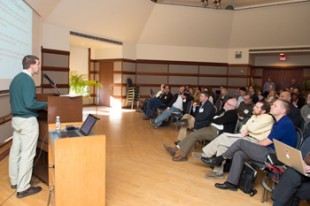Rice hosts first look at data from September flyovers, ground monitoring
The air was pretty nice in Houston last September except for one day that was, fortunately, rotten.
That day, Sept. 25, gave the scientists behind NASA’s DISCOVER-AQ experiment the data they needed to get a more complete picture of air quality in the region.
Rice University hosted the semiannual meeting of NASA’s Air Quality Applied Sciences Team (AQAST) Jan. 15-17 at the Farnsworth Pavilion. It featured the first presentation of preliminary results from DISCOVER-AQ’s September 2013 measurements of Houston air pollution from the ground, through mobile labs — including one operated by Rice and the University of Houston — and from the air, with high- and low-flying planes.

Rice environmental scientist Rob Griffin addresses members of the NASA Air Quality Applied Sciences Team at the Farnsworth Pavilion on Jan. 15. Photo by Jeff Fitlow
NASA established AQAST to promote the enhanced use of atmospheric observations and models to inform air-quality management. The team of 19 scientists — including Rice environmental engineering professor Daniel Cohan, who hosted this week’s meeting — works directly with government agencies, industry and other interested parties to produce research and tools that more closely integrate satellite data into air-quality planning.
DISCOVER-AQ was one of a number of air quality initiatives discussed at the meeting. Its immediate goal was to gather information about how well aerial monitoring can judge the amount of pollution at ground level. Eventually, NASA would like to measure surface pollution from satellites.
That’s not an easy task. When looking down through a column of air, a satellite will see all the pollution within that column. The ability to determine whether a plume of pollutants like ozone, methane or particulate matter is five or 5,000 feet off the ground would help atmospheric scientists forecast levels and locate sources.
The researchers are learning where pollution comes from, how it flows with the wind and weather and which pollutants are likely to travel at what altitudes. Pollution from vehicles, industry, forest fires, natural organic sources like farmlands and more can foul the air at any time, like it did Sept. 25.
That day, detectors captured an ozone spike of 175 parts per billion (ppb), far above the federal standard of 75 ppb. That spike, suspected to be the result of organic decay in farmlands west of Houston, may have been uncomfortable for humans, but it was a lucky break for the researchers.
“You want to see a wide a range of conditions and the broader, the wider that range you can capture, the better,” said NASA scientist James Crawford, principal investigator for DISCOVER-AQ. “So having that very polluted day was a boon to the experiment. But by the same token, the clean day was, also. We wanted to see the range, and sometimes it’s not until the end that you get the really big extreme event, and that was the case here.”
The mission flew nine times last September, with a low-flying P-3B and high-flying King Air sampling the atmosphere as they traced a repeated pattern that stretched from the Houston Ship Channel to northwest of the city, over Conroe. Early in the month, the researchers found ozone and methane levels to be fairly typical but not above the standards. In mid-month, one remarkably clean day set the low bar, Crawford said.
Levels of ozone and other air pollutants in Houston have generally been trending lower over the last two decades as the result of extensive regulatory efforts and emissions controls, Cohan said.
At the same time, the Rice/University of Houston mobile platform looked at levels of ozone and other pollutants, including particulate matter, on the ground, traveling the same routes from southeast to northwest that the planes were flying.
Rob Griffin, a Rice professor of civil and environmental engineering and a leader of the Rice/UH program, told the attendees that the mobile study’s continuing mission is to look at specific sources of pollutants. “This is our attempt to characterize the secondary processes that govern particulate matter in Houston, but also some of these sources that aren’t particularly well characterized in terms of their size and chemical nature,” he said.
“We’re culling through our data to look at, for example, (what happens) when we’re sitting in an oil tanker plume, when we’re sitting right next to certain petrochemical facilities over in the Houston Ship Channel, when we’re sitting right next to an open biomass burn and when we’re sitting right next to one of Houston’s famous barbecue pits. There are lots of instances where we’re looking at very specific, short-lived but clearly very important emission sources.”
The Houston Endowment-funded Rice/UH mission aims to gather data from neighborhoods for two years. That will be matched to health records collected over the last decade by the University of Texas Health Science Center at Houston.
More immediately, the ground data will be matched with levels measured by the planes and with balloons called ozonesondes launched by the University of Houston.
“The quality control on the data is just finishing up,” Crawford said. “We have to start putting them together, so we’ll spend some time looking at the ground measurements, the aircraft measurements and the remote measurements, all at the same time, first to assess consistency. You want to make sure there are no measurement errors.
“Once the measurement errors are gone, you can start to attribute structural phenomenon in the atmosphere that can either help or confound the connection you’re trying to make between the satellite and the ground measurement. That’s really where the science, from NASA’s perspective, comes in.”
Crawford expects the data will be useful for purposes beyond the NASA program. “One is that the state will be using it to assess their models and to basically strategize mitigation ideas on air quality,” he said.



Leave a Reply